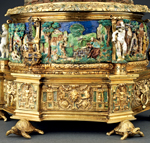Renaissance silver from the Schroder Collection
This exhibition is a wonderfully fresh take on collecting in the 19th century, says Philippa Glanville


Seventy-five objects from the distinguished but rarely seen Schroder Collection are currently on show in the jewel-box setting of the Wallace Collection. This is the latest, and, it must be said, the most glamorous of the museum's exhibitions on the history of collecting. Curated by Timothy Schroder and designed by John Ronayne, it takes a fresh look at an exceptional assemblage. A rare opportunity to enjoy wonderful objects, created for honour, wonder and display, the selection includes almost none of the practical plate for eating and drinking which predominates in the V&A, the Ashmolean and other museum collections. The strong complex forms and glinting surfaces of 'curiosities' composed from gilded silver, rock crystal, colourful enamel, exotic Wan Li porce-lain and Pacific nautilus shells stand out against striking, almost heraldic backdrops of red and green.
When Baron Sir John Henry Schroder (1825?1910) bought the early medieval Dolgellau chalice and paten in 1892, it was an unusually public acqui-sition, and fell outside his preferred focus on German goldsmiths' work of the Renaissance. He and his nephew, Baron Bruno Schroder, assembled an outstanding collection devised by European gold chasers, modellers, enamellers and cutters of hardstone. Now without rival as the finest of its kind still in private hands, it exemplifies the princely Schatzkammer, whose precious contents were so prized in Medici Florence, Charles I's Whitehall, at the Residenz in Munich and the Louvre of Louis XIII. Another early religious object is an enamelled and jewelled reliquary, made in about 1200 and thrown onto the market in 1790 when the treasury of Grandmont Abbey was broken up.
Rewarding details appear on close inspection of these intricate pieces: tiny soldiers are drawn up in formation on the poop of a galley (below) flying the standard of the Order of St John of Malta and a 16th-century Grand Prior. Typical of the playful Mannerist spirit which gave a perfunctory nod to function, they were devised above all to be 'curious' and to give pleasure. Delightful confections, masterpieces of the enamellers' and goldsmiths' artifice, they were to be appreciated and handled gently by a small circle of connoisseurs, often by candlelight.
Exceptions to this unifying principle are a Venetian rose water ewer and basin, whose rich figurative chasing was intended to divert guests as they rinsed their fingers after dining, and the towering Hamburg cup, standing more than 30in tall, which opens the exhibition. Resting on an absurdly small foot, this vivid expression of Mannerist exaggeration of scale may have been passed ceremoniously around for a toast, but it is essentially a sculpture for display on a buffet. A gift to Luneburg town council in 1602, its only parallel in Britain is the Dumling Cup at Kings Lynn, similarly massive, and presented to the town in the 1630s by a successful Baltic merchant.
Deborah Lambert's essay on the Schroders as collectors, and Mr Schroder's discussions of the objects, plus notes on princely collecting, enrich both the graphics and the accompanying book. Armed with a discriminating eye and meticulous scholarship, Mr Schroder has chased up lost provenances, for example, the Saxon princely collection in Dresden. An 1830s sale there was the source of a London-mounted rock-crystal cup. Practicality, in a mundane 20th-century sense, was neither desired nor demanded. The magic of these objects lies in their intricate workmanship and costly materials, in their bravura scale and their condition, barely touched in four centuries of existence. Treasured by their patrons, they have been protected by leather cases or frames, handled only by privileged intimates or shown as dazzling embellishments to a room.
This distinguished collection sheds an intriguing light on 19th-century attitudes and art-market values. Concern for the histories of things, how attitudes to them have changed over time, and questions of survival now attract great interest. This excellent exhibition can be enjoyed on several levels.
'Renaissance Silver from the Schroder Collection' is at the Wallace Collection, Hertford House, Manchester Square, London W1, until October 14 (020?7563 9500; www.wallacecollection.org)
Sign up for the Country Life Newsletter
Exquisite houses, the beauty of Nature, and how to get the most from your life, straight to your inbox.
Country Life is unlike any other magazine: the only glossy weekly on the newsstand and the only magazine that has been guest-edited by HRH The King not once, but twice. It is a celebration of modern rural life and all its diverse joys and pleasures — that was first published in Queen Victoria's Diamond Jubilee year. Our eclectic mixture of witty and informative content — from the most up-to-date property news and commentary and a coveted glimpse inside some of the UK's best houses and gardens, to gardening, the arts and interior design, written by experts in their field — still cannot be found in print or online, anywhere else.
-
 380 acres and 90 bedrooms on the £25m private island being sold by one of Britain's top music producers
380 acres and 90 bedrooms on the £25m private island being sold by one of Britain's top music producersStormzy, Rihanna and the Rolling Stones are just a part of the story at Osea Island, a dot on the map in the seas off Essex.
By Lotte Brundle
-
 'A delicious chance to step back in time and bask in the best of Britain': An insider's guide to The Season
'A delicious chance to step back in time and bask in the best of Britain': An insider's guide to The SeasonHere's how to navigate this summer's top events in style, from those who know best.
By Madeleine Silver